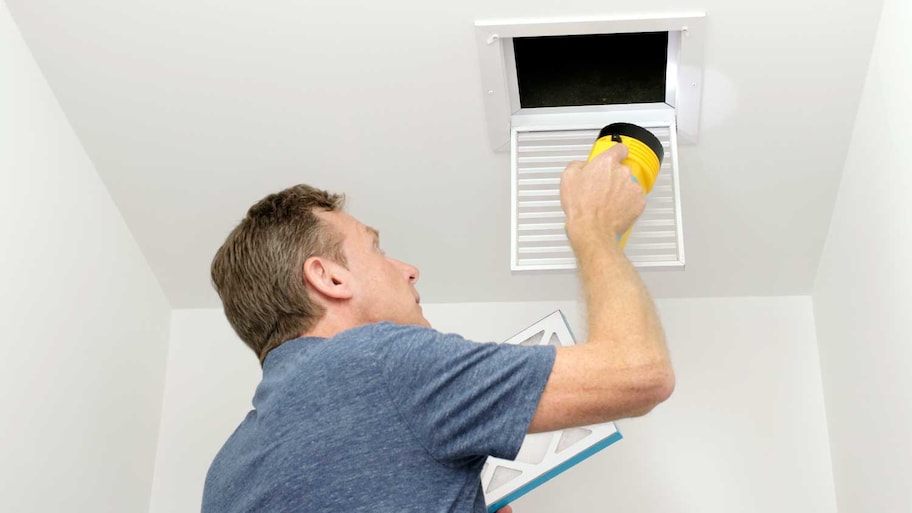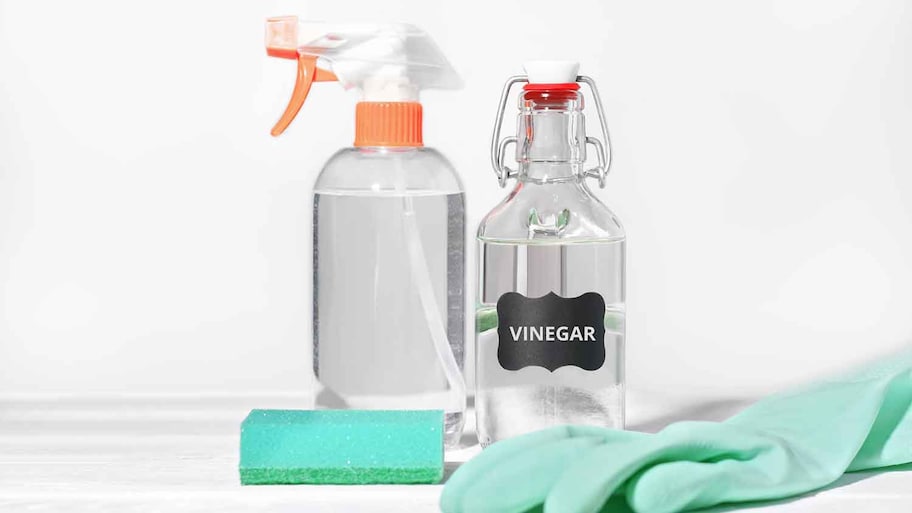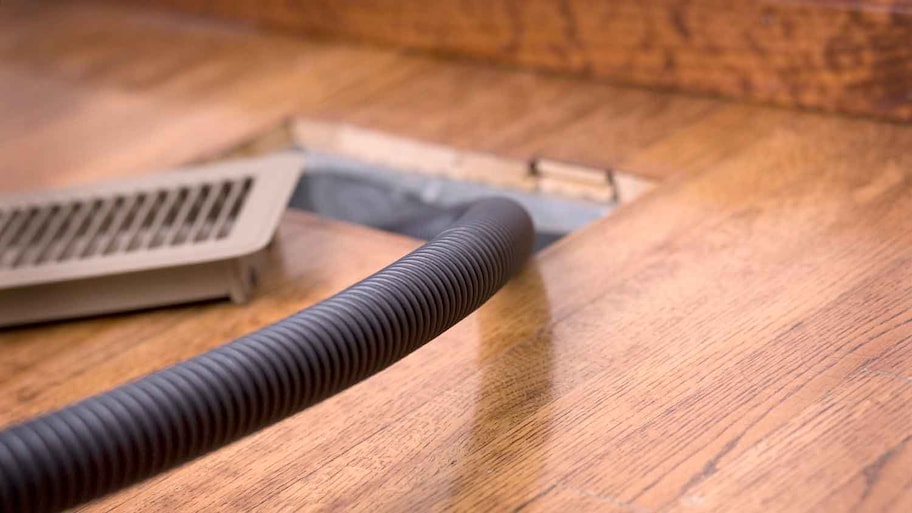How to Get Rid of Mold in Air Ducts: 7 Potential Methods
A few hours to a healthier home


Mold growth inside your home’s air ducts can pose health risks and compromise the efficiency of your HVAC system. Tackling mold in air ducts requires a strategic approach, and understanding the potential methods for removal is critical. Fortunately, savvy DIY homeowners can learn how to get rid of mold in air ducts, and keep their air healthy.
Why Do I Have Mold in My Air Ducts?
Various factors can lead to mold growth in air ducts, but one of the primary causes is moisture. Homes that have experienced water damage, leaks, or high humidity levels are particularly susceptible to mold growth. Poorly sealed or insulated ductwork can accumulate moisture from leaks or condensation, creating a perfect environment for mold. Additionally, inadequate ventilation can worsen the issue. Plumbing leaks, roof leaks, and flooding can also introduce moisture into the home, eventually making its way into the air ducts.
Dust and debris buildup in the ductwork can also create an environment for mold growth, particularly when combined with moisture. HVAC systems with dirty filters or contaminated coils can also contribute to mold proliferation. It is important that you regularly inspect and maintain your HVAC system, as well as promptly address any water-related issues to prevent mold in your air ducts. Consulting with a professional for a thorough assessment and remediation is highly recommended if the source or extent of the problem is uncertain, ensuring a lasting and comprehensive solution.
How Much Does it Cost to Remove Mold from Air Ducts?
If you have a minor mold issue in your air ducts and choose to go the DIY route, it can cost as low as $20 when using natural mold killers. If you use tools, such as a vacuum or fogger, renting these could cost about $50 while investing in these tools may run upwards of $200. For large mold issues, hiring a mold remediation specialist is your best option. The average mold remediation cost ranges between $1,125 and $3,345.
Signs of Mold in Air Ducts

Ensuring high-quality indoor air and averting potential health concerns requires detecting the presence of mold in air ducts. Below are common symptoms of mold in air ducts:
Visible Mold Growth: When examining the ductwork, pay close attention to visible components like vents and registers, searching for any indications of mold growth. Mold often presents itself in the form of discolored patches, with shades of green, black, or brown, and it may possess a fuzzy or slimy texture. Should you observe any such mold on these surfaces, it is an indication that the ducts may be compromised.
Musty Odors: A lingering musty or moldy scent is a common indicator of mold in air ducts. The detection of unpleasant smells when your HVAC system is operational could imply the existence of mold or mildew. These odors are typically more noticeable after the system has remained dormant for some time, like when you initiate the heating or cooling process.
Allergy Symptoms: When mold spores are dispersed into the air through the HVAC system, they have the potential to cause allergic reactions in individuals who are prone to them. If anyone in the home is experiencing a rise in symptoms associated with allergies, such as coughing, sneezing, itchy eyes, or respiratory problems, it may be a sign of mold growing within the air ducts.
Inefficient HVAC System: When mold grows in air ducts, it can obstruct the airflow, leading to a less efficient performance from the HVAC system. Pay attention to signs of a decline in the system's performance, such as uneven heating and cooling or reduced airflow. These indications may suggest that there is mold or other obstructions present in the ductwork.
How To Get Rid of Mold in Air Ducts
Seeking professional help for mold removal in air ducts is usually the recommended course of action due to the intricacies and potential health hazards involved. However, for mild cases, there are several DIY measures that you can take to get rid of mold in air ducts. It is important to note, however, that consulting with experts is advisable if the mold issue is widespread, or if you have any health-related concerns. If you do choose to DIY to solve this issue, ensure you wear a mask, goggles, and gloves to reduce potential health risks.
Use Baking Soda
With its antimicrobial and mild abrasive properties, baking soda offers a practical DIY solution for tackling mold in air ducts. To use, simply mix baking soda with water to form a paste and apply it to any visible mold on accessible duct surfaces. Allow the paste to settle before scrubbing the mold gently with a brush and wiping it clean with a rag. Not only does baking soda absorb moisture, but it also neutralizes odors and inhibits mold growth.
Use Vinegar

To combat mold growth in air ducts, white vinegar can be used as a DIY solution due to its natural antimicrobial properties. Mix equal parts of white vinegar and water to create a solution, and apply it to visible mold on accessible surfaces using a spray bottle or cloth. Allow the solution to sit for a while, and then gently scrub and wipe away the mold. Vinegar can effectively kill mold spores and prevent further growth.
Use Tea Tree Oil
Tea tree oil is a natural solution to eradicate mold in air ducts, thanks to its powerful antifungal and antibacterial properties. To apply it, mix a few drops of tea tree oil with water, then use a cloth or spray bottle to distribute the solution over visible mold in the ductwork. After allowing the mixture to sit for a bit, scrub the mold away and wipe the area clean.
Use Hydrogen Peroxide
Similar to tea tree oil, hydrogen peroxide features potent antifungal and antibacterial properties that can work as a DIY remedy for banishing mold in air ducts. Combine equal amounts of 3% hydrogen peroxide and water to create a solution. Apply it to visible mold on accessible areas of the ductwork and let the solution sit for at least 10 minutes before scrubbing the mold away.
Use Borax
Borax is a natural mineral known for its fungicidal properties that can be an effective DIY solution for getting rid of mold in air ducts. Mix borax with water and apply it to any visible mold, and then carefully scrub the affected areas to wipe them clean. Not only is borax effective in inhibiting mold growth, but it can also protect against future infestations.
Use HEPA Vacuum

To address mold in air ducts, using a HEPA (High-Efficiency Particulate Air) vacuum is a helpful DIY method. A HEPA vacuum is capable of capturing tiny particles, including mold spores, with its filters and preventing them from being released into the air during cleaning. When using this vacuum for duct cleaning, concentrate on the easily accessible vents and components. It's important to note that while this approach can improve air quality by decreasing the amount of mold spores, it may not eliminate the cause of mold growth, like hidden moisture problems.
Use a Mold Removal Fogger
A mold removal fogger can also be used to eliminate mold from air ducts. It dispenses a fine mist of mold-killing solution throughout the ductwork, which accesses hard-to-reach areas and effectively coats the surfaces, preventing the recurrence of mold. It is important to only use a mold removal solution approved for fogging machines, which you can rent from most hardware stores. Although a fogger is a convenient method for treating air ducts, it’s important to follow safety guidelines, ensure proper ventilation, and use protective gear.
Tips for Preventing Mold in Air Ducts
Preventing mold growth in air ducts is crucial for maintaining indoor air quality and preventing potential health issues. Using preventive measures can significantly reduce the risk of mold growth in your air ducts, contributing to a healthier indoor environment. Regular maintenance and vigilance are key to keeping your HVAC system and air ducts mold-free.
Here are tips to minimize the risk of mold in your air ducts:
Control Moisture: To prevent the growth of mold, it’s important to manage moisture levels in your home. Make a habit of checking for any signs of leaks, water damage, or condensation around windows and pipes. Swift action should be taken to fix any issues, and to maintain good ventilation in areas prone to moisture, such as kitchens, bathrooms, and basements. Installing exhaust fans and using a dehumidifier can also be helpful.
Routine HVAC Maintenance: Work with your local HVAC professional to routinely maintain your HVAC system. This includes replacing filters, cleaning coils, and checking the ductwork for any signs of mold or debris. By staying on top of maintenance, you can significantly reduce the likelihood of mold growth and other problematic conditions within your HVAC system.
Use Quality Air Filters: Upgrade your HVAC system with HEPA filters, which effectively capture even the smallest particles such as mold spores, preventing their circulation through the ducts and ensuring the air quality of your living spaces remains pristine.
Install UV Lights: Installing ultraviolet (UV) lights within the HVAC system can eliminate mold spores and other microorganisms that pass through the ducts. Though not a standalone solution, these lights can work in tandem with other preventive measures to enhance their efficacy.
Protect Ductwork: Proper sealing and insulation of ductwork is essential in preventing condensation and reducing the possibility of moisture buildup in the ducts. Adequate insulation also plays a critical role in ensuring consistent temperatures, ultimately reducing the risk of mold development.
DIY vs Hiring a Pro
If you're facing a minor mold issue in your air ducts and can visibly see the infested area, DIYing mold removal can be an effective solution. However, air duct systems are complex and mold growth can easily occur in concealed or inaccessible locations. Trying to address mold issues on your own may not prove successful in entirely eradicating all spores or dealing with the underlying issue. There is a reasonable risk of not removing mold entirely or unknowingly propagating the mold further throughout the ventilation system.
Hiring a mold remediation specialist is an excellent option as these professionals are experienced and possess the specialized equipment to effectively remove mold in air ducts. A professional can conduct thorough inspections, identify the source of moisture causing mold growth, and employ advanced methods to address the issue.
Engaging professionals for mold removal is often the wisest decision, especially when dealing with extensive contamination or recurring mold problems. Professionals possess the expertise and tools required to tackle larger-scale contaminations, guaranteeing that air ducts are cleaned, sanitized, and restored to a safe and healthy state. Mold exposure can cause significant health risks, and air duct systems can be intricate. As a result, it is advisable to enlist professionals to ensure thorough mold removal.
Frequently Asked Questions
Inhaling mold spores that circulate through HVAC systems can cause a range of health problems, especially for people with respiratory issues or weakened immune systems. Sneezing, coughing, and itchy eyes are common allergic reactions to mold exposure. In severe cases, long-term exposure can lead to respiratory problems, sinus congestion, and worsen asthma symptoms. It's crucial to address mold in air ducts immediately through thorough remediation to minimize health risks and ensure a safer indoor environment.
It is common for mold to grow around air vents, especially in areas with high humidity or moisture problems. These vents provide a perfect environment for mold to thrive due to the condensation caused by the meeting of warm and cool air. Mold growth can be accelerated by the presence of dust and debris around the vents. Regular maintenance, proper ventilation, and addressing any water leaks or excess humidity can prevent the growth of mold around air vents.
Several factors contribute to the persistent growth of mold in vents, with excess moisture being the most common culprit. Consistent mold formation in vents indicates an ongoing moisture problem within the HVAC system or its surroundings, likely caused by condensation on cool surfaces in areas with high humidity. Moisture accumulation can also result from leaks in ductwork, inadequate ventilation, or insufficient insulation, creating an environment favorable for mold growth. Regular inspections, addressing potential sources of moisture, maintaining proper ventilation, and routine HVAC maintenance can help prevent the recurrence of mold in vents. If the issue persists, seek professional assistance to identify and rectify the underlying problems.
